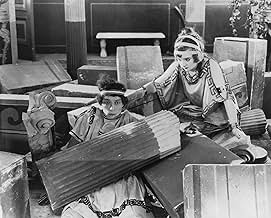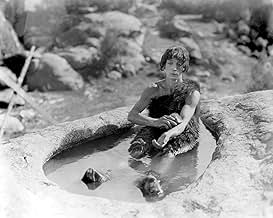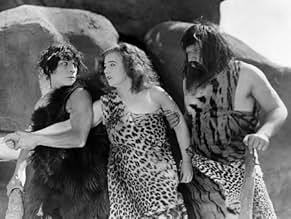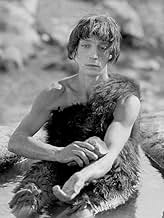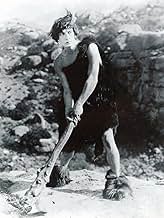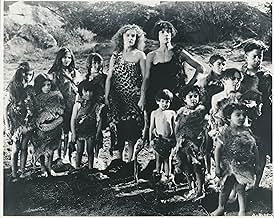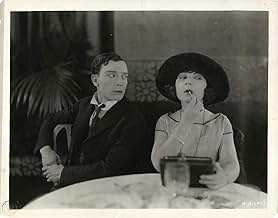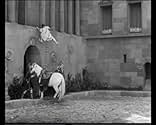ÉVALUATION IMDb
7,0/10
5,6 k
MA NOTE
Ajouter une intrigue dans votre langueThe misadventures of Buster in three separate historical periods.The misadventures of Buster in three separate historical periods.The misadventures of Buster in three separate historical periods.
- Prix
- 1 nomination au total
Kewpie Morgan
- The Emperor
- (as Horace Morgan)
- …
Lionel Belmore
- Undetermined Role
- (unconfirmed)
- (uncredited)
Bernard Berger
- Roman-age child
- (uncredited)
Basil Bookasta
- Stone Age Child
- (uncredited)
George Bookasta
- Stone Age Child
- (uncredited)
George Davis
- Roman Guard Knocked Down
- (uncredited)
Louise Emmons
- Old Fortune Teller
- (uncredited)
F.F. Guenste
- Butler
- (uncredited)
Blanche Payson
- The Amazon
- (uncredited)
Avis en vedette
D.W. Griffith could have made any movie he wanted to after the enormous financial success of "The Birth of a Nation"; he chose to make the most technically ambitious film to that date, "Intolerance". He took a risk with such innovations in film montage and form, and the well-known financial train wreck resulted. Buster Keaton doesn't take that kind of a risk with "Three Ages", a parody of "Intolerance". This is Keaton's first feature-length film of his own (he only acted in "The Saphead"). He had the fallback plan of dividing the three episodes in this feature into three separate shorts, which Griffith did do with "Intolerance". Keaton didn't have to. Chaplin had already succeeded with feature-length comedies, so if Keaton was taking a risk here, it was completely calculated.
Chaplin had already done a parody of another film, too, with "Burlesque on Carmen" (1915). Keaton appears to allude to that parody, as well. The wrestling scene in the Ancient Rome episode references the swordfight that turns into a wrestling match in Chaplin's burlesque. The comical distance from the plot of both scenes is the same, too. Furthermore, Chaplin's film imitated the glossy style of DeMille's "Carmen", and Chaplin's film seemed a tribute to that film. Keaton doesn't attempt the radical editing, narrative structure or monumental nature in his parody, but it seems respectful of "Intolerance" nonetheless. At least, the stories aren't told completely straightforward as in other "Intolerance"-inspired works, such as Dreyer's "Leaves from Satan's Book" (Blade af Satans bog, 1921) and Fritz Lang's "Destiny" (Der Müde Tod, 1921). There is some mild jumping back and forth between episodes.
Where Keaton did take risks, however, is in his physical, daredevil comedy. That's Keaton unintentionally failing to jump across buildings in the modern episode. Reportedly, he was convinced to alter the scene rather than attempt the jump again. And, it wasn't just Keaton who took risks; the anachronistic baseball gag, for example, was rather dangerous. Thus, although in a different way, Keaton, like Griffith, took risks with his big film. And, I think they both succeeded.
Chaplin had already done a parody of another film, too, with "Burlesque on Carmen" (1915). Keaton appears to allude to that parody, as well. The wrestling scene in the Ancient Rome episode references the swordfight that turns into a wrestling match in Chaplin's burlesque. The comical distance from the plot of both scenes is the same, too. Furthermore, Chaplin's film imitated the glossy style of DeMille's "Carmen", and Chaplin's film seemed a tribute to that film. Keaton doesn't attempt the radical editing, narrative structure or monumental nature in his parody, but it seems respectful of "Intolerance" nonetheless. At least, the stories aren't told completely straightforward as in other "Intolerance"-inspired works, such as Dreyer's "Leaves from Satan's Book" (Blade af Satans bog, 1921) and Fritz Lang's "Destiny" (Der Müde Tod, 1921). There is some mild jumping back and forth between episodes.
Where Keaton did take risks, however, is in his physical, daredevil comedy. That's Keaton unintentionally failing to jump across buildings in the modern episode. Reportedly, he was convinced to alter the scene rather than attempt the jump again. And, it wasn't just Keaton who took risks; the anachronistic baseball gag, for example, was rather dangerous. Thus, although in a different way, Keaton, like Griffith, took risks with his big film. And, I think they both succeeded.
"The Three Ages," Buster Keaton's first feature-length film after a number of comedy shorts, is his parody of Griffith's "Intolerance." Keaton tells three parallel stories about the perils of romance, one set in the Stone Age, one during the Roman Empire, and one during the 20th century.
In the context of Keaton, I don't see "The Three Ages" given a lot of mention. This is a shame, since while it's not Keaton's finest work, it ranks with his funniest. In one scene, Buster falls into a pit with a lion. Afraid of getting eaten, he pampers the lion and gives it a manicure. What follows is one of the funniest visual gags I've ever seen.
In the context of Keaton, I don't see "The Three Ages" given a lot of mention. This is a shame, since while it's not Keaton's finest work, it ranks with his funniest. In one scene, Buster falls into a pit with a lion. Afraid of getting eaten, he pampers the lion and gives it a manicure. What follows is one of the funniest visual gags I've ever seen.
The more time I spend with old films, the more of a giant I see Keaton to be. I'm beginning to think that we all need to see a lot of him, which is why I wandered into this. It seems to have been made only because they had access to a Roman set.
The setup is that a courtship story is presented in three eras: a cave-man setup, a Roman context and a modern one. All are based on film notions of those eras of course. Unlike most movie humor of the time, the joke here isn't in embellishing the story with humorous decoration. Its in the difference among the stories.
Its a clever piece of what I call folding, and you will see at least one scene here that I swear is quoted in "Rashomon."
So there's the idea of the thing, which is worthwhile, but now I've explained it, you hardly have to see it. The jokes are trite. But there is one scene that I recall over and over. I think Keaton did it elsewhere and several others too, but here it is the best.
He's driving a car, a rickety one to his girl's house. (This is in the modern setting, obviously.) He hits a bump and the car falls to pieces. And I just don't mean the wheels fall off, the car quite literally disassembles into the parts that went into the factory and there he sits among hundreds of items. I have no idea how he did this. The car really is moving as a car, and then in an instant it is in pieces.
Wonderful.
Ted's Evaluation -- 3 of 3: Worth watching.
The setup is that a courtship story is presented in three eras: a cave-man setup, a Roman context and a modern one. All are based on film notions of those eras of course. Unlike most movie humor of the time, the joke here isn't in embellishing the story with humorous decoration. Its in the difference among the stories.
Its a clever piece of what I call folding, and you will see at least one scene here that I swear is quoted in "Rashomon."
So there's the idea of the thing, which is worthwhile, but now I've explained it, you hardly have to see it. The jokes are trite. But there is one scene that I recall over and over. I think Keaton did it elsewhere and several others too, but here it is the best.
He's driving a car, a rickety one to his girl's house. (This is in the modern setting, obviously.) He hits a bump and the car falls to pieces. And I just don't mean the wheels fall off, the car quite literally disassembles into the parts that went into the factory and there he sits among hundreds of items. I have no idea how he did this. The car really is moving as a car, and then in an instant it is in pieces.
Wonderful.
Ted's Evaluation -- 3 of 3: Worth watching.
For me, Keaton's decision to make a parody of Griffith's Intolerance so that if the feature (his first) failed he could re-edit and release it as three two-reelers is what diminishes the enjoyment for me. The film jumps back and forth between the three time periods, and so all of them seem to be over before they've really begun, and the film has something of a disjointed feel. Perhaps this is because the film does actually feel as if it is three two-reelers spliced together rather than an actual feature.
The comedy is unevenly paced, but when it hits the mark it is near-perfect. Highlights include Keaton's drunken encounter with Wallace Beery, other diners, and a crab at a restaurant, and the jaw-dropping leap from one roof to another at what looks like hundreds of feet above the ground (apparently the buildings were short sets placed on a bridge overlooking a view of Los Angeles. Just as well, because Keaton failed to make the leap successfully and fell from the second building, a real-life mishap that remains in the film). Keaton slides through a window, across a room, down a pole (at this point we realise he is in a fire station although he doesn't) and lands on the back of a fire engine that returns him to the police station from which he has just escaped. The whole sequence is both side-splitting and astounding. The look on Keaton's face as he looks quizzically up at the pole he has just descended is priceless. Perhaps because of his status as a comic genius we tend to forget how good an actor Keaton was .
I liked the modern sequence best, and had it been released as a short I believe it would be considered one of his classics. The caveman sequence is OK, but the Roman era story tends to drag.
It's been well publicised that this was competition winner Margaret Leahy's only film because she was so untalented as an actress, and it's true she doesn't light any fires while on-screen. But the impact of her ineptitude in front of the camera is cleverly avoided by the likes of Keaton and Beery merely acting around her as if she were just another prop.
Overall, this isn't one of Keaton's best - although that is probably because this is his first feature. Keaton himself thought it was just OK and, given his instinctive sense for what works, perhaps that should tell us all we need to know...
The comedy is unevenly paced, but when it hits the mark it is near-perfect. Highlights include Keaton's drunken encounter with Wallace Beery, other diners, and a crab at a restaurant, and the jaw-dropping leap from one roof to another at what looks like hundreds of feet above the ground (apparently the buildings were short sets placed on a bridge overlooking a view of Los Angeles. Just as well, because Keaton failed to make the leap successfully and fell from the second building, a real-life mishap that remains in the film). Keaton slides through a window, across a room, down a pole (at this point we realise he is in a fire station although he doesn't) and lands on the back of a fire engine that returns him to the police station from which he has just escaped. The whole sequence is both side-splitting and astounding. The look on Keaton's face as he looks quizzically up at the pole he has just descended is priceless. Perhaps because of his status as a comic genius we tend to forget how good an actor Keaton was .
I liked the modern sequence best, and had it been released as a short I believe it would be considered one of his classics. The caveman sequence is OK, but the Roman era story tends to drag.
It's been well publicised that this was competition winner Margaret Leahy's only film because she was so untalented as an actress, and it's true she doesn't light any fires while on-screen. But the impact of her ineptitude in front of the camera is cleverly avoided by the likes of Keaton and Beery merely acting around her as if she were just another prop.
Overall, this isn't one of Keaton's best - although that is probably because this is his first feature. Keaton himself thought it was just OK and, given his instinctive sense for what works, perhaps that should tell us all we need to know...
Although the movie is clearly dated, audiences can still easily identify with the plight of hapless Buster in this timeless and very funny underdog tale. Buster fights against unkindly odds in three different ages: the Stone Age, The Roman Age, and the Moden Age, playing almost the same character with just a change of scenery to help us identify the different "ages". In this movie we see one of the earliest comedic depictions of the "caveman" stereotype, who wins his love not by romance but by brute force, as well as a funny twist on Roman gladiatorial combat, two comedic sketches that long predate such spoofs as Mel Brooks' "History of the World: Part I". The underlying theme of the movie is simple yet convincing: Although the times may have-a-changed, we still face the same struggles even in modern times that we fought in prehistoric times in order to "win the girl" (keep in mind this is the theme of 1923 America, a time when chauvinism was still en vogue). It is interesting to look at this movie over eighty years later, and consider how dramatically things have changed from this movie's "modern times" to now.
Le saviez-vous
- AnecdotesThe most famous stunt in the movie was actually built around what went wrong with the original stunt. Buster Keaton intended to leap from a board projecting from one building onto the roof of another building, but he fell short, smashing into the brick wall and falling into a net off-screen. He was injured badly enough to be laid up for three days. However, when he saw the film (the camera operators were instructed to always keep filming, no matter what happened), he not only kept the mishap, he built on it, adding the fall through three awnings, the loose downspout that propels him into the firehouse and the slide down the fire pole.
- GaffesIn the medium shot of the Stone Age soothsayer scene, Buster's hands are resting together near the side of the turtle. But in the cut to a close-up, we see only a hand double's right hand, and it's directly in front of the turtle's mouth. (It's clearly a hand double, since Keaton was missing his right index finger tip.)
- Autres versionsIn 1995, Film Preservation Associates copyrighted a version with an orchestral score; no details were specified on the print.
- ConnexionsEdited into The Golden Age of Buster Keaton (1979)
Meilleurs choix
Connectez-vous pour évaluer et surveiller les recommandations personnalisées
- How long is Three Ages?Propulsé par Alexa
Détails
Box-office
- Brut – à l'échelle mondiale
- 177 $ US
- Durée
- 1h 3m(63 min)
- Couleur
- Mixage
- Rapport de forme
- 1.33 : 1
Contribuer à cette page
Suggérer une modification ou ajouter du contenu manquant

